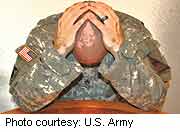

With a newly developed computer model, researchers were able to successfully predict which 5 percent of U.S. Army soldiers committed more than one-third of all major Army workplace violent crimes over a six-year period.
The researchers said that the model could help identify service members who need intensive interventions. Such interventions, they suggested, might help prevent this type of violence.
“The fact that the model identifies such a high proportion of violent crimes is especially exciting because the variables used in the model are routinely collected administrative data the Army can use to identify high-risk soldiers without carrying out expensive one-on-one clinical assessments,” the study’s lead author, Anthony Rosellini, a postdoctoral fellow at Harvard Medical School in Boston, said in a school news release.
The researchers used Department of Defense and Army records for the study. They reviewed information on almost 1 million regular U.S. Army soldiers. The soldiers were on active duty from 2004 through 2009.
The researchers then created a computer model with that information to predict who would go on to commit serious violent crimes.
The investigators found that the 5 percent of soldiers identified as having the highest predicted risk accounted for 36 percent of all major physical violent crimes committed by men, and 33 percent of the crimes committed by women during the six-year study.
The study findings were published online Oct. 6 in Psychological Medicine. The study was funded by the U.S. Department of Defense.
The researchers also tested the model on a more recent group of Army personnel. The study period for this group was from 2011 to 2013. The 5 percent of soldiers with the model’s predicted highest risk accounted for 50 percent of all major physical violent crimes, the study showed.
“These numbers are striking,” the study’s principal investigator, Ronald Kessler, a professor of health care policy at Harvard Medical School, said in the news release.
“They show us that predictive analytic models can pinpoint the soldiers at highest violence risk for preventive interventions. Targeting such interventions might be the best way to bring down the violent crime rate in the Army,” he added.
The study’s co-author, John Monahan, a professor of law at the University of Virginia School of Law, said that “it is important to recognize that severe violent crimes are uncommon even in this high-risk group. This means that implementing intensive high-risk preventive interventions would make sense only if the interventions are shown to be highly efficient, something that has not yet been demonstrated.”
More information
The U.S. Department of Veterans Affairs provides a variety of mental health services for soldiers.
Source: HealthDay
Copyright © 2024 HealthDay. All rights reserved.

Leave a Reply